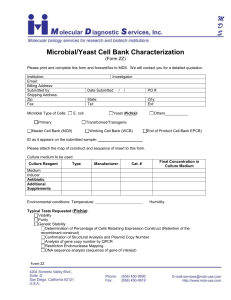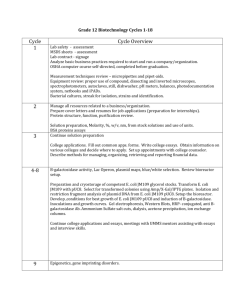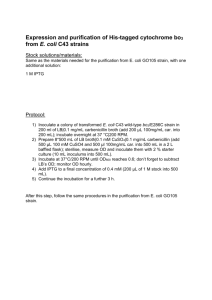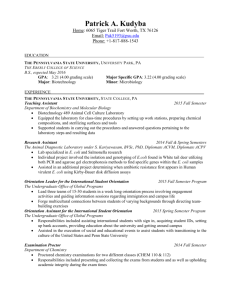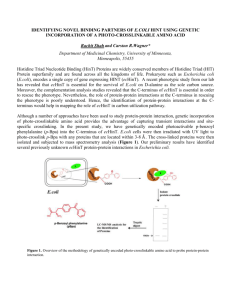SUPPORTING INFORMATION
advertisement
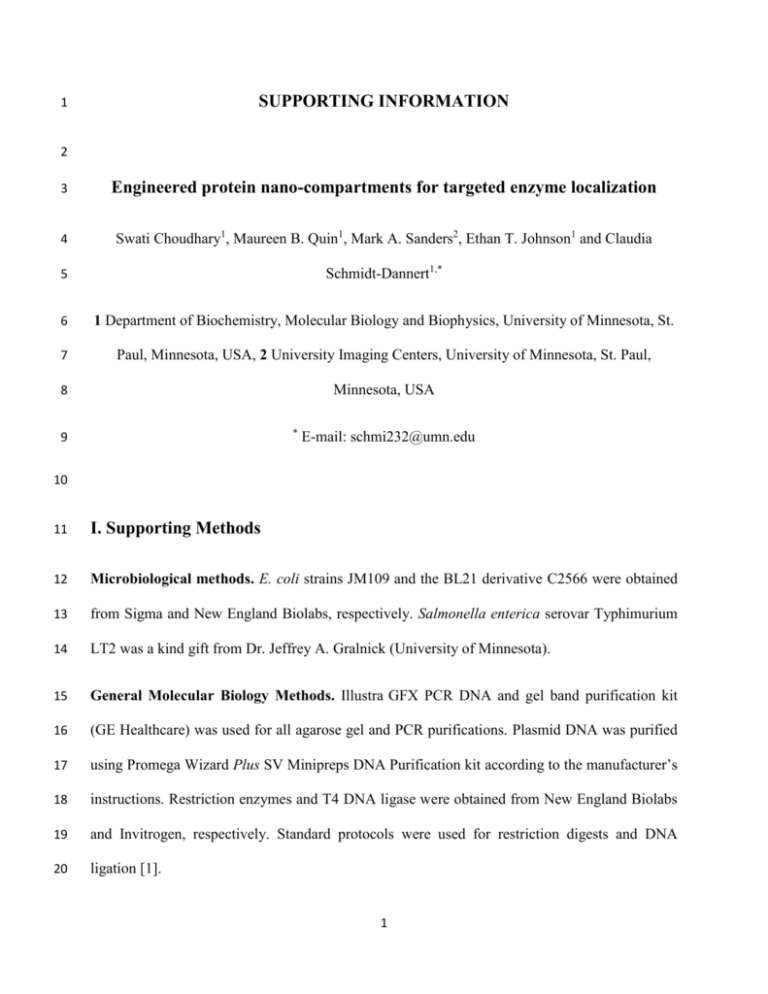
SUPPORTING INFORMATION 1 2 3 Engineered protein nano-compartments for targeted enzyme localization 4 Swati Choudhary1, Maureen B. Quin1, Mark A. Sanders2, Ethan T. Johnson1 and Claudia 5 Schmidt-Dannert1,* 6 1 Department of Biochemistry, Molecular Biology and Biophysics, University of Minnesota, St. 7 Paul, Minnesota, USA, 2 University Imaging Centers, University of Minnesota, St. Paul, 8 Minnesota, USA * 9 E-mail: schmi232@umn.edu 10 11 I. Supporting Methods 12 Microbiological methods. E. coli strains JM109 and the BL21 derivative C2566 were obtained 13 from Sigma and New England Biolabs, respectively. Salmonella enterica serovar Typhimurium 14 LT2 was a kind gift from Dr. Jeffrey A. Gralnick (University of Minnesota). 15 General Molecular Biology Methods. Illustra GFX PCR DNA and gel band purification kit 16 (GE Healthcare) was used for all agarose gel and PCR purifications. Plasmid DNA was purified 17 using Promega Wizard Plus SV Minipreps DNA Purification kit according to the manufacturer’s 18 instructions. Restriction enzymes and T4 DNA ligase were obtained from New England Biolabs 19 and Invitrogen, respectively. Standard protocols were used for restriction digests and DNA 20 ligation [1]. 1 1 BioBrickTM-based expression vectors. The BioBrickTM strategy allows for rapid sub-cloning of 2 genes into several vectors using the same set of restriction enzymes (Fig. S1). Our in-house 3 BioBrickTM expression vectors have a constitutively active modified lac promoter (Plac*) [2,3]. 4 Various open reading frames can be inserted between the BglII and NotI sites downstream of 5 Plac*. pUCBB (ampicillin resistance) and pACBB (chloramphenicol resistance) have ColE1 and 6 p15A origins of replication, respectively, while pBBRBB (kanamycin resistance) is derived from 7 the broad-host-range vector pBBR1MCS [4]. 8 Cloning of Eut genes. Eut shell genes were amplified from Salmonella enterica LT2 genomic 9 DNA (ATCC Catalog no. 700720D-5) using gene-specific primers. Restriction sites for BglII 10 and NotI were added to the 5’ end of the forward and reverse primers, respectively. Each PCR 11 product was gel purified and digested with BglII and NotI, followed by ligation with BglII/NotI 12 digested pUCBB. All cloned sequences were confirmed by DNA sequencing. 13 EutS, EutMN and EutLK were cloned into our in-house BioBrickTM constitutive expression 14 vector pUCBB (Fig. S1). Their expression cassettes were stacked sequentially to produce the 15 vectors pUCBBEutMNLK and pUCBBEutSMNLK. To stack the Eut expression cassettes, 16 pUCBBEutMN and pUCBBEutLK were digested with EcoRI/SpeI and EcoRI/XbaI respectively. 17 XbaI and SpeI produce compatible DNA ends that upon ligation generate a ‘scar’ which cannot 18 be recognized by either enzyme. The Plac*-EutMN DNA fragment was ligated into digested 19 pUCBBEutLK to produce the vector pUCBBEutMNLK. Next, pUCBBEutS was digested with 20 EcoRI/SpeI, and the Plac*-EutS fragment ligated into EcoRI/XbaI digested pUCBBEutMNLK to 21 produce the final vector pUCBBEutSMNLK. EutM, EutN, EutL and EutK were also cloned 22 singly to study their individual contributions to BMC formation. For expression in S. enterica, 2 1 EGFP, EutC1-19-EGFP and EutG1-19-EGFP were further sub-cloned into our in-house broad-host- 2 range BioBrickTM expression vector pBBRBB. 3 Protein analysis. E. coli C2566 cells were grown at 37 °C for SDS/PAGE analysis of recombinant Eut 4 protein expression, which was performed using standard methods [1]. Total cellular protein was 5 extracted from pelleted overnight cultures using BugBuster (Novagen) extraction reagent. The 6 extracts were centrifuged (12,000 rpm, 15 minutes, 4 °C) to separate the soluble and insoluble 7 fractions. Protein concentrations were determined using Bio-Rad protein assay reagent (Bio- 8 Rad). For studying expression of recombinant Eut proteins, PAGE was performed using 15% 9 SDS gels and Bio-Rad Mini-Protean II electrophoresis cells as per the manufacturer’s 10 instructions. The protein gels were subsequently stained with Bio-Safe Coomassie Blue (Bio- 11 Rad). Silver staining was used to visualize purified Eut BMC proteins. 12 Western detection of EutC1-19-EGFP from purified BMCs. Purified native Eut BMCs and 13 recombinant EutSMNLK and EutS BMCs harboring EutC1-19-EGFP were broken by sonication. 14 10 µg of broken and intact BMCs were loaded in separate lanes of a 10 % native polyacrylamide 15 gel. 16 visualized by silver staining. Proteins were also transferred to a PVDF membrane (Roche), and 17 GFP was detected using a primary anti-GFP antibody and a secondary horseradish peroxidase- 18 conjugated antibody. A chromogenic developing solution was prepared using a one:one ratio of 19 luminol/enhancer solution and stable peroxide solution (Thermo Scientific), and was applied to 20 the membrane. 21 (Bioexpress) for 2 minutes, and the film was subsequently developed. Following electrophoresis under non-denaturing conditions, migration of proteins was The membrane was placed in a film cassette and was exposed to film 3 1 Anti-GFP immunofluorescence studies. E. coli cells were suspended in PBS for microwave- 2 assisted low temperature processing. Microwave-assisted low temperature processing was 3 conducted in a Pella Biowave Pro microwave processor equipped with a ColdSpot™ load cooler, 4 vacuum system, and variable wattage. Bacterial pellets were initially fixed using 0.1 % 5 glutaraldehyde, 4 % paraformaldehyde, and 0.1 M sodium phosphate buffer (pH 7.2), in the 6 microwave processor at 150 watts for 12 min (5 min on, 2 min off, 5 min on) at 4 °C. 7 Subsequently, the cells were mounted on 10-welled microscope slides, permeabilized in -20 °C 8 methanol for 10 min, and allowed to air dry. Drops of blocking buffer (PBS (pH 7.2) with 5 % 9 normal goat serum, 1 % glycerol, 0.1 % BSA, 1 % fish skin gelatin, and 0.04 % sodium azide) 10 were placed on the attached cells for 15 minutes at room temperature. Specimens were reacted 11 overnight at 4 oC with the anti-GFP antibody diluted 1:50 (Invitrogen, Catalog no. A11122) and 12 then incubated with Alexa 568 goat anti-rabbit IgG for 2 h at 37 °C. Finally, the cells were 13 washed and mounted in Prolong Gold with DAPI. Preparations were viewed using the E800 14 microscope as described in the main text. 15 Anti-GFP immunogold labeling and TEM. After microwave processing, the cell pellets were 16 pre-embedded in 2 % NuSieve agarose (Cambrex Life Sciences), and washed twice for 30 min 17 each in phosphate buffer at 4 °C. Dehydration substitution procedures were conducted in a block 18 of dry ice with 1.5 ml microfuge tubes placed in 100 % solvent filled pre-drilled holes. Samples 19 were dehydrated/substituted in 50 %, 75 % and 96 % Methanol, 1:1 96% Methanol: LR White 20 resin, 100% LR White sequentially at dry ice temperatures in the presence of microwaves with 21 the following wattages and times: 150 watts for 12 min (5 min on, 2 min off, 5 min on) each. 22 The LR White infiltrated samples where then embedded with fresh LR White resin followed by 4 1 polymerization at 42 °C for 18 h. The polymerized blocks were sectioned (90 nm) with diamond 2 knives and placed on formvar-coated nickel 200 mesh grids. 3 For immunogold labeling, sections were labeled for anti-GFP (Invitrogen, Catalog no. A11122) 4 using the indirect immunogold labeling technique. Grids with sections were floated on drops of 5 blocking buffer, consisting of PBS, pH 7.2, with 5 % normal goat serum, 1 % glycerol, 0.1 % 6 bovine serum albumin (Fraction V; Sigma), 1 % fish skin gelatin, and 0.04 % sodium azide for 7 15 minutes at room temperature (RT). Specimens were reacted overnight at 4 oC with the anti 8 GFP antibody diluted 1:50. After washing seven times in droplets of PBS, the sections were 9 incubated with 20 nm goat anti-rabbit IgG (1:50 dilution, GE Healthcare). After washing seven 10 times with droplets of PBS, the sections were fixed in 1 % glutaraldehyde followed by rinsing on 11 a droplet of water eight times. All sections were stained for 5 minutes with uranyl acetate and 5 12 minutes with lead citrate before observation on a Phillips CM 12 TEM. 13 Nile Red assay: Overnight cultures of bacteria were incubated with Nile Red (final 14 concentration 1 µg/ml) for five minutes in the dark. Fluorescence visualization was performed 15 using the Nikon E800 microscope as described in the main text. 16 17 References 18 19 20 21 22 23 24 25 1. Sambrook J, Fritsch EF, Maniatis T (1989) Molecular cloning: a laboratory manual: Cold Spring Harbor Lab Press, Cold Spring Harbor, NY. 2. Schmidt-Dannert C, Umeno D, Arnold FH (2000) Molecular breeding of carotenoid biosynthetic pathways. Nat Biotechnol 18: 750-753. 3. Vick JE, Johnson ET, Choudhary S, Bloch SE, Lopez-Gallego F, et al. (2011) Optimized compatible set of BioBrick vectors for metabolic pathway engineering. Appl Microbiol Biotechnol 92: 1275-1286. 4. Kovach ME, Phillips RW, Elzer PH, Roop RM, Peterson KM (1994) pBBR1MCS: a broad-host-range cloning vector. Biotechniques 16: 800-802. 5 1 2 II. Supporting Figure Legends 3 Figure S1. BioBrickTM vectors and strategy for stacking multiple genes into a single 4 plasmid. (A) Our in-house BioBrickTM vectors contain an expression cassette with a constitutive 5 promoter (Plac*) and an EGFP reporter. (B) Cloning of Eut BMC shell genes into pUCBB. (i) 6 EutS, EutMN and EutLK were cloned downstream of the constitutive Plac* promoter (blue arrow) 7 using BglII and NotI. (ii) and (iii) Expression cassettes for EutMNLK and EutSMNLK were 8 created as described in Supporting Methods. 9 Figure S2. SDS/PAGE analysis showing recombinant expression of S. enterica Eut shell 10 proteins in E. coli. (A) Overexpression of Eut shell proteins in the E. coli strain C2566. (B) 11 Overexpression of Eut shell proteins in the E. coli strain JM109. (c) Overexpression of wild type 12 EutS and the EutS-G39V mutant in E. coli strains C2566 and JM109. 15µg soluble protein 13 fraction was loaded in each lane. Expected protein sizes are as follows: EutS (11.6kDa), EutM 14 (9.8 kDa), EutN (10.4kDa), EutL (22.7 kDa), EutK (17.5 kDa), and EGFP (26.9 kDa). Proteins 15 were stained with Coomassie Blue. 16 Figure S3. Transmission electron micrographs of thin sections of recombinant E. coli 17 expressing S. enterica Eut shell proteins. (A-C) E. coli expressing recombinant EutS contain 18 properly delimited shells (E. coli strain used in A: C2566, and in B, C: JM109). (D-F) E. coli 19 expressing recombinant EutM form thick axial filaments that interfere with separation after cell- 20 division (E. coli strain used in D, E: C2566, and in F: JM109). (G) E. coli JM109 expressing 21 recombinant EutN. (H) E. coli JM109 expressing recombinant EutL. (I) E. coli JM109 22 expressing recombinant EutK shows an electron translucent region in the middle of the cell. (J) 6 1 An electron dense region is visible in E. coli JM109 co-expressing recombinant EutM and EutN. 2 (K) Intracellular filaments are formed in E. coli JM109 co-expressing recombinant EutL and 3 EutK. (L-N) Clearly defined shells are observed in E. coli JM109 expressing recombinant 4 EutSMNLK. (O-Q) Co-expression of EutSMNLK and EutC1-19-EGFP results in the formation of 5 compartments that are morphologically similar to the shells observed in vivo by expression of 6 either EutS or EutSMNLK alone. (E. coli strain used in O: C2566, and in P, Q: JM109). Arrows 7 indicate the location of recombinant shells. (Scale bar: 200nm). 8 Figure S4. Localization of EutC1-19-EGFP in recombinant E. coli JM109 cells expressing S. 9 enterica Eut shell proteins. Fluorescence microscopy images of E. coli JM109 cells co- 10 expressing EGFP or EutC1-19-EGFP with EutS (wild type and the G39V mutant), EutMNLK or 11 EutSMNLK. See Table S2 for the quantification of EGFP localization in recombinant E. coli, 12 and Fig. 4 for the localization of EutC1-19-EGFP in the E. coli C2566 strain. Cell boundaries are 13 shown by the DIC images. 14 Figure S5. Localization of EutC1-19-EGFP in recombinant E. coli C2566 cells expressing 15 various combinations of S. enterica Eut shell proteins. Fluorescence microscopy images of E. 16 coli C2566 cells with constructs for constitutive expression of EGFP or EutC1-19-EGFP with 17 EutM, EutN, EutL, EutK, EutMN and EutLK. In the absence of EutS, there is no discrete 18 fluorescent localization of EutC1-19-EGFP, which indicates that EutS is required for targeting 19 EutC1-19-EGFP to the engineered microcompartments. Cell boundaries are shown by the DIC 20 images. 21 Figure S6. Nile Red staining of recombinant E. coli expressing EutC1-19-EGFP. E. coli 22 C2566 cells co-expressing EutC1-19-EGFP and EutS or EutSMNLK were stained with the 7 1 fluorescent, lipophilic inclusion body stain Nile Red. Co-localization of red and green 2 fluorescence was not observed, indicating that the recombinant Eut shells are not inclusion 3 bodies nor are the surrounded by a hydrophobic matrix. 4 Figure S7. Nile Red staining of recombinant E. coli expressing NSC1. E. coli C2566 cells co- 5 expressing the cyanobacterial carotenoid cleavage dioxygenase NSC1 either alone or with EutC1- 6 19 7 presence of NSC1, co-localization of red and green fluorescence was not seen, showing that 8 EutC1-19-EGFP is not targeted to NSC1 inclusion bodies. 9 Figure S8. Transmission electron micrographs of partially purified protein compartments. 10 (A) Native Pdu BMCs isolated from S. enterica. (B) Native Eut BMCs and recombinant Eut 11 protein shells isolated from cells not expressing the cargo protein EutC1-19-EGFP. From left to 12 right: Native Eut BMCs isolated from S. enterica, recombinant EutSMNLK shells isolated from 13 E. coli C2566, and recombinant EutS shells isolated from E. coli C2566. Scale bar: 100nm. 14 Figure S9. Immunofluorescence analysis of EutC1-19-EGFP localization in recombinant E. 15 coli expressing Eut shell proteins. EGFP, anti-GFP antibody (red) and merged EGFP-anti-GFP 16 antibody fluorescence signals from E. coli cells with constructs for constitutive expression of 17 EGFP or EutC1-19-EGFP with EutS or EutSMNLK. (A) anti-GFP immunofluorescence studies in 18 the E. coli strain C2566. (B) anti-GFP immunofluorescence studies in the E. coli strain JM109. 19 Figure S10. Separation of EutC1-19-EGFP from broken and intact Eut shells by native 20 polyacrylamide electrophoresis. Visualization of protein migration by silver stain of native 21 gel. EGFP control is shown in lane 1, followed by broken (lane 2) and intact (lane 3) Eut BMCs 22 from S. enterica cells harboring EutC1-19-EGFP; broken (lane 4) and intact (lane 5) recombinant -EGFP. While red fluorescent puncta corresponding to inclusion bodies were observed in the 8 1 EutSMNLK BMCs co-expressing EutC1-19-EGFP; and broken (lane 6) and intact (lane 7) 2 recombinant EutS BMCs from E. coli C2566 cells co-expressing EutC1-19-EGFP. 3 Video S1: Dynamics of EutC1-19-EGFP in S. enterica grown on ethanolamine. 4 Representative time-lapse movie of S. enterica cells harboring pBBRBB-EutC1-19-EGFP, and 5 grown in the presence of ethanolamine. Discrete fluorescent foci are observed to be in motion 6 within the S. enterica cells, suggesting that Eut BMCs (which would be expected to encapsulate 7 EutC1-19-EGFP) are moving around within the cell. Time stamp on video indicates elapsed time. 8 Preparations were viewed using a Nikon Eclipse E800 photomicroscope. Time-lapse images 9 were collected at 15 second intervals. Shutters were opened only during camera exposure. 9

